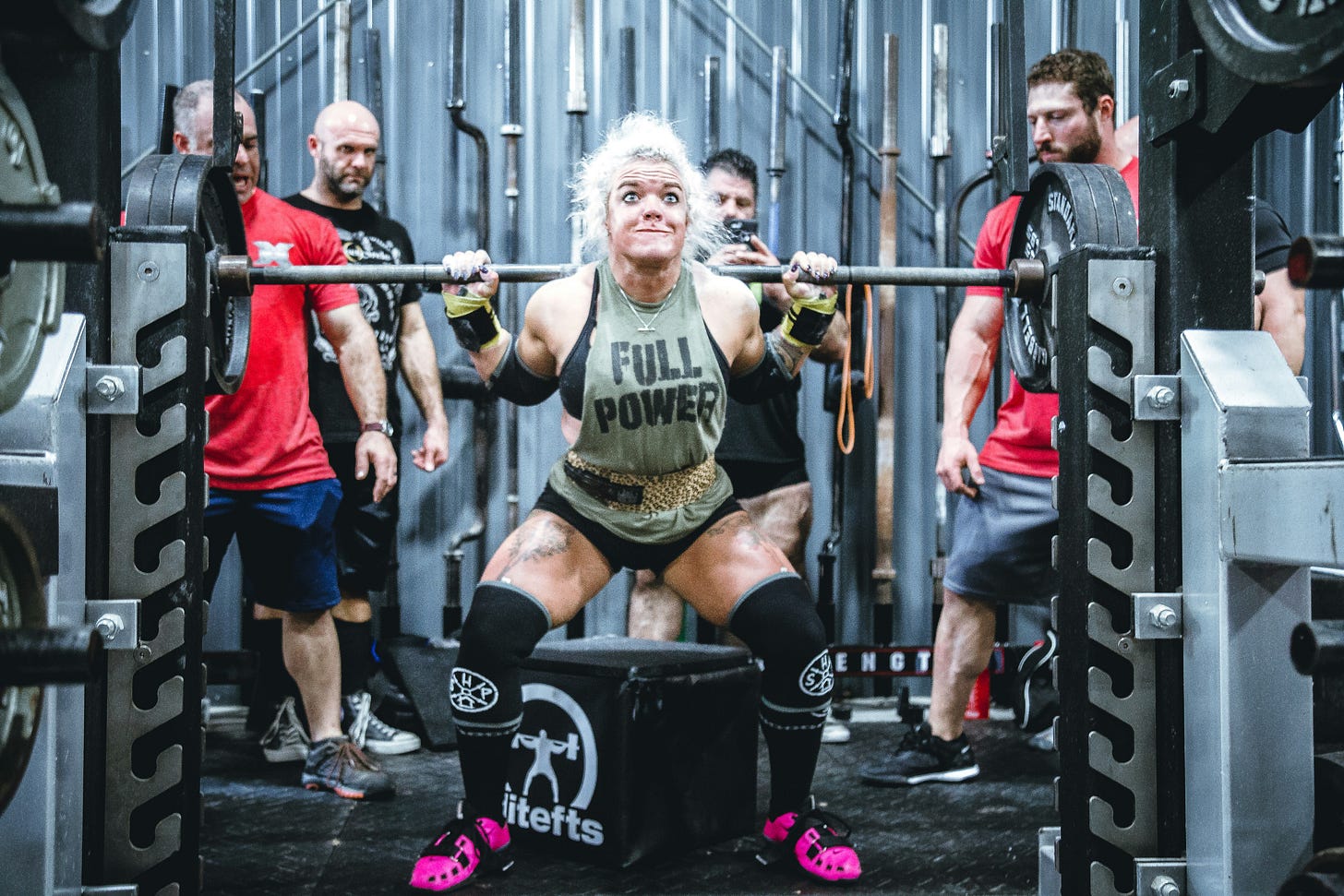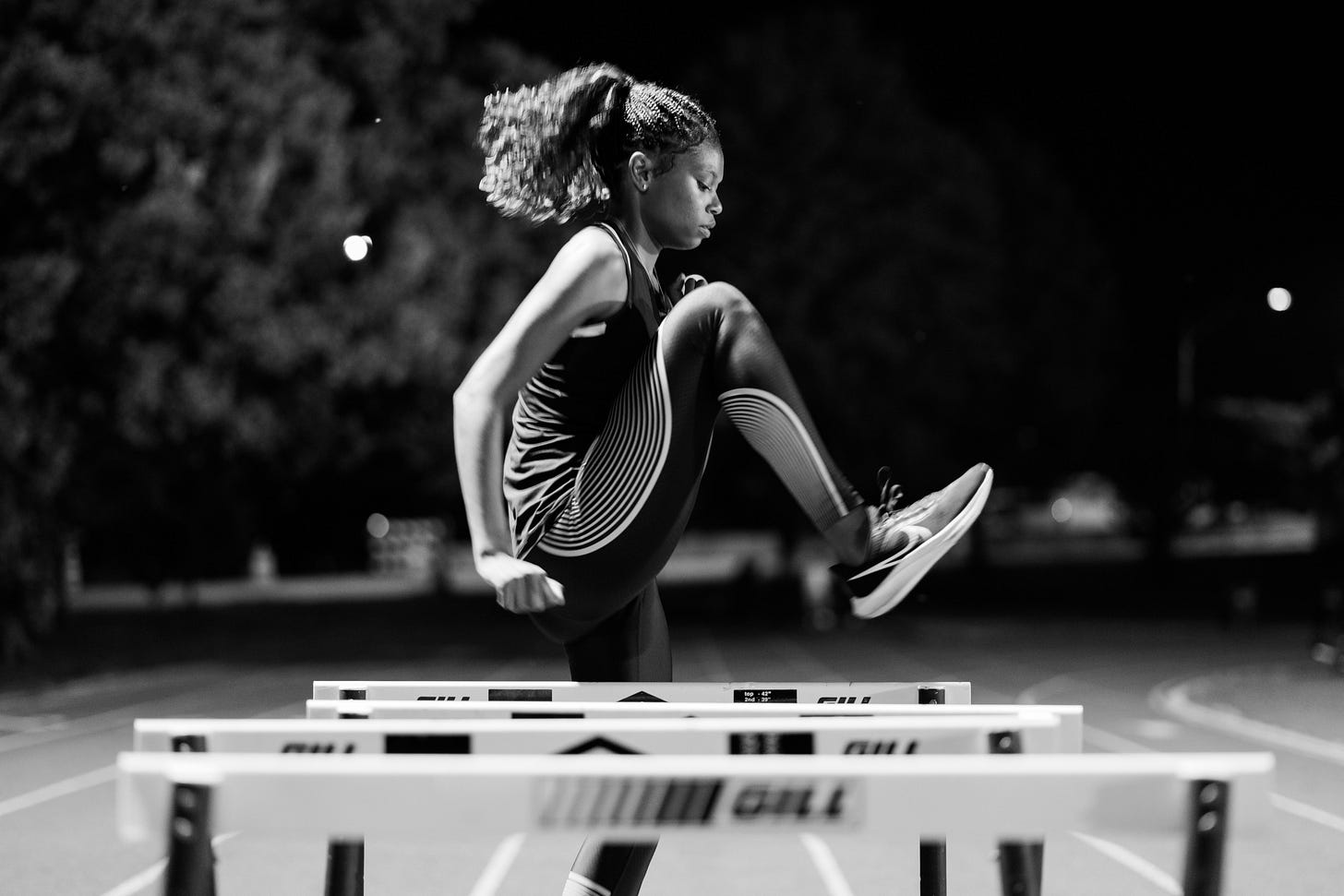Bleed, Lift, Repeat: Training Like a Woman with a Body That Knows Better
Why it's time we stop training like little men in leggings

I want to say this plainly: women are not small men. Not in physiology. Not in psychology. Not in how we train, how we recover, or how we relate to our bodies.
And yet, every single training plan I have ever followed—every “get strong” guide, every “shred” challenge—was built for a body that wasn’t mine. A body that didn’t bleed monthly. A body that didn’t surge with hormones, that didn’t crave chocolate or cry for no reason or bloat like a wounded pelican three days before a period. A body that differed drastically in how it operates, and what it is capable of compared to the standard male form that most fitness and exercise guides are based on.
Understanding the unique characteristics of being born biologically female has been critical to healing my body, staying safe and building my strength.
I recognise this journey and experience looks very different for those who are not cis-gendered like myself. This article is not intended to reduce or demean the experiences of transgender, intersex or non-binary individuals and how they navigate their bodily autonomy or experience. I recommend checking out this article on how gym’s can be a minefield for those working out when non-binary. This piece is speaking to the experiences of a cis-gendered woman trying to find her way to health, wellbeing and fit in an industry that ignores the reality of her vagina, hormones and physiology.
Finding my form: PTs, periods, and the politics of fitness

When I started my fitness journey, I hired a personal trainer. I have chronic back issues that had sidelined my many past attempts to get stronger- and, if I’m honest, to lose weight. This time, I knew I needed professional support.
Someone who could meet me where I was. Someone who could understand my physical limitations, help me build consistency, and guide me toward a movement-based lifestyle. Someone who could make me feel confident and safe in a gym. Because let’s be real- gyms can be intimidating and distracting places.
I will park my strong feelings on the smells and focus on the people. It’s hard to say who distracts me more: the hormone-fuelled twenty-something bros who clearly skipped leg day one too many times; or the hyper-flexible, scantily clad yoga ladies in arse-enhancing leggings and zero shelf support for the “girls." Both groups tend to focus more on performative gym attendance and their Instagram stories, than on health. Mostly, I find myself consistently annoyed by them hogging the equipment while endlessly scrolling. A PT helped cut through the chaos and find my confidance to navigate whatever gym equipment was left, in people-free spaces I could find.
More importantly, he became a guide for training and healing my body. I chose him because he was over the age of 12 and, as his profile proudly noted, was a “former fat kid.” He’s popular with women- yes, he's easy on the eyes (sorry if you’re reading this!)- but the real draw was his honesty. A man who named the struggle we all have with our body. A struggle that ultimately is a lifelong journey of building, and maintaining, a healthy relationship with a real and lived body. That is something that resonates deeply with women of all shapes and stages.
He understood that fitness and physical health is not just about willpower, as diet culture insists. It’s about genetics, mental well-being, and the small, consistent choices that either support or sabotage a healthy relationship with ourself.
Still, I was a different kind of client. Unapologetically honest. I updated him regularly on my menstrual cycle- every time he asked how I was feeling, I offered context: where I was in my cycle, how my energy and pain were shifting, how to tweak our plan accordingly.
He was adjusting for back pain and loading patterns. I was adjusting for hormones, energy, and emotional bandwidth.
During ovulation, I was unstoppable- lifting heavy, chasing PBs, energized by peaking estrogen. But days later, my body would crash. My back flared in pain to my hormonal fuelled enthusiasm. I felt emotionally fragile. Progesterone took the wheel. Anxiety, cravings, and self-doubt set in. During my luteal phase I’d eat all my feelings in a rush of anxiety and depression that my body would never be right, or able to do things I truly wanted.
But we didn’t stop. We adapted.
When my back flared, we kept me moving- but gently.
When I was bleeding, we scaled back cardio to match my energy.
When I was ovulating, we avoided high-coordination drills because honestly, I’m clumsy enough without my joints getting lax.
As a woman not on hormonal contraception, tracking my natural cycle became one of the most powerful tools in understanding my body. My physiology isn’t linear- and neither is my training.
Your body has a blueprint so why aren’t we using it?

Too many of us have been taught to override our bodies. To ignore our cycles. To treat our physiology as a flaw to conquer.
But female physiology is not a bug of the human condition- it's a feature. The female endocrine system is an intelligent web of hormones that influences our strength, mood, metabolism, and coordination. It represents a "series of glands that produce hormones and secretes them into the bloodstream." It is designed to guide our body in every moment and in every movement. I will leave the complex science to the side, but it is worth noting that for those on hormonal birth control this looks different. Hormonal contraception manipulates the body's hormonal system to prevent pregnancy by mimicking hormonal patterns that regulate reproduction.
Whether you're on hormonal contraception or not, understanding how the female body is designed and tends to operate, is essential to training safely and effectively. Our experiences are uniquely individual, but there are important trends in our physiology and the patterns of our hormones that are important to inform training cycles for everyone.
For years we've trained in systems designed for male bodies- flat, linear, unchanging. We were handed one-size-fits-all programs and told the problem was our willpower. Not the spreadsheet.
For years, we’ve trained like small men in pink leggings. Following programs that ignore the fact that our bodies ebb and flow with surging hormones one week that flatline the next.
Your body isn’t broken. It’s not inconsistent. It’s not weak. It’s not confused. It’s cyclical.
This isn’t about special treatment. It’s about specific treatment.
It’s about knowledge, nuance, and knowing that your hormones and your body aren’t the enemy, they’re the map.
What the science says about our physiology, performance and risk of injury

This isn’t just anecdotal evidence or influencers on TikTok. The science is showing signs that our physiology isn’t a flaw to overcome- it's a system to understand.
A systematic review published in Sports Medicine (2020) analyzed more than 50 studies finding trends across them that hormonal fluctuations across the menstrual cycle can influence strength, endurance, and recovery. The early follicular phase, just after menstruation, was associated with slightly improved performance outcomes across various studies. So what does this mean for the average woman- not just elite athletes or data points? Performance can vary week to week, with the most consistent strength and power gains likely during the follicular phase. That’s not inconsistency- it’s biology. Though it is worth noting there were limitations in the quality of these studies “due to the trivial effect size, the large between-study variation and the number of poor-quality studies included in this review. ” Consequently, broad recommendations for exercise performance across the menstrual cycle can’t yet be reliably made. Instead, the current evidence suggests that training should be tailored to each individual’s unique physiological responses throughout their cycle.
A 2024 paper in Progress in Brain Research further demonstrated how the menstrual cycle affects key systems such as thermoregulation, neuromuscular control, and substrate metabolism- all essential to training efficiency and recovery. So if you feel like you’re flying one week and wading through molasses the next, it’s not inn your head- it’s your hormones doing what they’re designed to do.
Researchers are increasingly moving from understanding to application in real-world settings. The IMPACT Study (2024) is a randomized controlled trial that tested whether aligning endurance training with the menstrual cycle leads to improved performance outcomes.The results could revolutionize athletic programming at every level and finally validate what women have long felt in their bodies.
Like most areas of women’s health research, menstrual cycle research remains woefully underfunded and undervalued—often limited in rigour, sample size, and methodological soundness. As Caroline Criado-Perez outlines in her brilliant book Invisible Women, this is part of a much broader gender data gap that permeates medical research and treatment.
While we still need more robust, inclusive research to conclusively demonstrate consistent effects of menstrual cycle phases on performance, energy, or fatigue- what we do have offers directional insights that a personalised approach to training that recognises the unique physiology and endocrinology of women is not just beneficial- it’s essential.
So track and train. Because every woman, every cycle, and every session is different.
The myth of female fragility in training and sport

Throughout history we’ve been told that women are too emotional, too hormonal, too fragile. Even in sports, this myth has followed us everywhere- supposedly our fragility makes it hard to train, seriously. But what if the real issue isn’t our bodies- but the systems that refuse to account for them?
Take ACL injuries, for example. For years, they’ve been blamed on hormonal fluctuations, particularly around ovulation, when estrogen is thought to increase joint laxity. However the 2022 Disability Sport Wales report challenges this narrow lens, calling it “lazy science.” The report highlights that biomechanics, training load, movement patterns, and even social conditioning play a far more complex role in injury risk. Reducing female vulnerability to a hormonal narrative not only oversimplifies the issue it reinforces damaging stereotypes.
That said, hormones do matter- particularly when it comes to recovery, adaptation, and fatigue. According to Pure Sports Medicine, the follicular phase is best suited for high-intensity training and muscle adaptation. In contrast, the luteal phase, when progesterone is dominant, may slow recovery, elevate perceived exertion, and increase fatigue. They recommend periodising training to reduce injury risk and prevent overtraining, while still respecting the capacity of the female body.
Fuck the current fitness system- let’s build our own

Yes, hormones influence how you recover, adapt, and perform. But with awareness and intelligent training design, you can lower injury risk, optimize gains, and finally feel like your body is working with you- not against you.
When we stop pathologizing the female body and start programming with it in mind, we don’t just train better- we reclaim our power.
Women’s fitness needs to be built on the foundation of female physiology. This isn’t about fragility or excuses- it’s about realizing that we’ve been playing the game on someone else’s field, with someone else’s rules.
You are not inconsistent. You are not weak. You are not “too hormonal.” You are not unpredictable. You are cyclical- and that’s powerful.
From a young age, we’re taught to hide our periods, and by adulthood, that silence often turns into disconnection. Many of us grow up illiterate in the language of our own hormones and cycles- missing out on the signals that could help us move, train, and live more wisely.
Exercise isn’t just about aesthetics or performance. It’s about building a lifelong relationship with your body so you can live the life you want.
That relationship requires understanding, respect, and response. Female endocrinology and physiology are not just considerations- they’re tools.
And yes, in a world where hormonal contraception plays a central role, this looks different for everyone. For many, birth control is a form of autonomy and relief- from the fear of pregnancy or the pain of periods. I’m not here to suggest it’s wrong- it’s absolutely not. In fact, it’s often essential. But we also need to acknowledge that a generation is growing up disconnected from the natural cycles that shape their physiology.
The ability to “fornicate without fear”- a freedom I’ve joyfully embraced- can come with trade-offs: a blurring of connection with the natural rhythms that shape our bodies. We don’t all need to be seed-cycling, moon-tracking, free-bleeding goddesses. But we do deserve the choice to understand our biology.
Cycle-informed training won’t be right for everyone. Your body, your choice. And that choice should be informed by your stage of life, your goals, and, ideally, by trusted healthcare professionals who understand and can help inform you decision-making.
What is critical is that we start training from a place of understanding, and with an awareness of our own physiological blueprint. As Dr. Stacy Sims writes in her seminal text, Roar, "women are not small men. Stop eating and training like one."
When we recognize our rhythm and the lived reality of the bodies we were born with, everything shifts.
Maybe it helps you push for a personal best.
Maybe it helps you pull back when you need to.
Maybe it just gives you permission to lean into PMS, skip the burpees, and eat the damn ice cream. Between us? Always eat the fucking ice-cream.
To every woman trying to navigate fitness in a world that wasn’t built for us, know that your body is not broken and your hormones are not the enemy.
It’s time we all unlearned the shame and embraced what the science is telling us.
Train boldly my dear. Train cyclically.
Train like a woman who finally knows her body is not the problem.
It’s the solution- a mother fucking superpower really.
xo
🔥 Fuel for Thought
📖 Must Read “Roar: How to Match Your Food and Fitness to Your Unique Female Physiology for Optimum Performance, Great Health, and a Strong, Lean Body for Life” by Stacy Sims and Selene Yeager
This is the life-changing bible that will transform how you understand your body, health and fitness. Dr. Sims is not only a nutrition scientist and exercise physiologist but also an athlete herself. It covers everything from pregnancy to menopause, female digestive tract and nutritional recommendations, and unique insights into women’s physiology. Evidence-backed, compelling story-telling!
📅 Tools to Track and Plan: Wild.Ai
Wild.AI isn’t just another period tracker—it’s built for active women, syncing training, recovery, and nutrition advice to your unique hormonal patterns. Unlike most apps that stop at symptom logging, Wild uses real science to help you optimize performance at every phase of your cycle—not just survive it.
🎙️Listen to Dr. Brittany Barreto’s Femtech Focus Podcast
Femteh Focus is hosted by the absolutely brilliant and bodacious Brittany and focuses on all things female health and femtech related. It wil change your life with unique industry insights and innovations on all things health related.





I think it's important to note that the systematic review you linked actually says this in its conclusion:
"Due to the trivial effect size, the large between-study variation and the number of poor-quality studies included in this review, general guidelines on exercise performance across the MC cannot be formed; rather, it is recommended that a personalised approach should be taken based on each individual's response to exercise performance across the MC."
This is what I've learned through my own reporting (article forthcoming) on the notion of cycle syncing training. The science has not found consistent evidence that different cycle phases affect women's exercise performance, energy levels, etc., in the same ways. While individual women may notice differences between the phases, these differences are not consistent across the board.
Thanks Meredith for this. I'll make some updates and very kean to see your article on this!